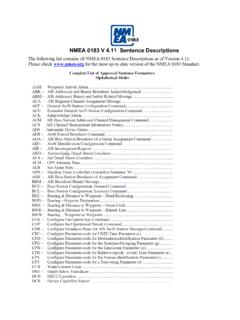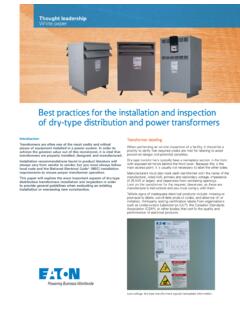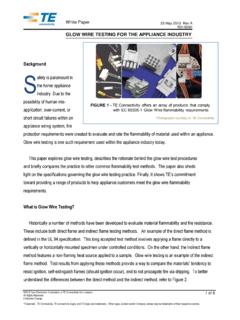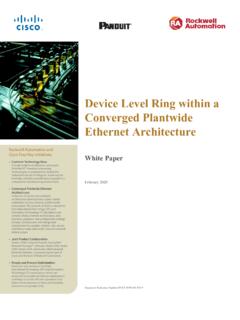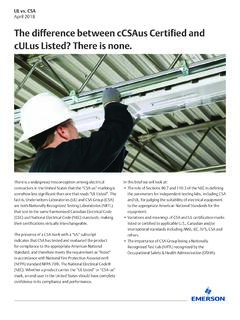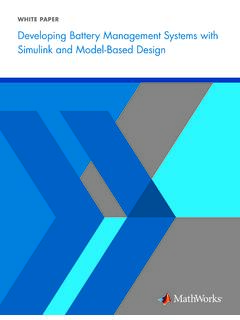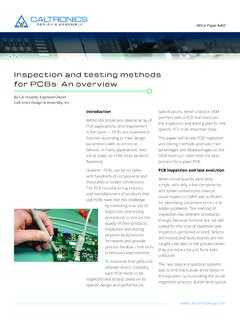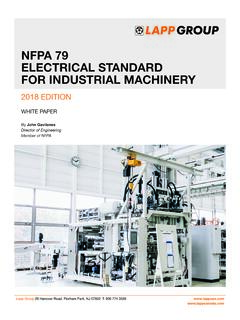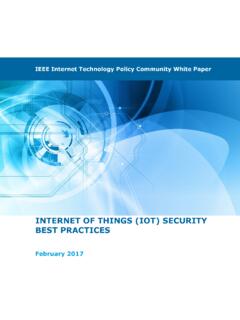Transcription of An Introduction to NMEA 2000
1 1 March 2, 1999 NMEA 2000 Explained - The Latest Word Frank Cassidy - Chairman, NMEA Standards Committee Preview: Over the past two years a number of articles and committee reports have appeared in this magazine describing the to and from as the NMEA 2000 network standard was being developed by the NMEA Standards Committee Working Group 2000. An Introduction to NMEA 2000 in the May/June 1997 issue provided an overview of the network specification and described the development process. Key to NMEA 2000 is an integrated circuit implementation of a network access protocol commonly known as CAN.
2 The September/October 1997 issue described the features of CAN in the article NMEA 2000 & the Controller Area Network. Having selected CAN as a building block for NMEA 2000 it was possible to define the requirements of the physical layer that interconnects the nodes in an NMEA 2000 network. These requirements were described in the March/April 1998 article NMEA 2000: The Physical Layer. The remaining elements necessary to define a network to be used in multiple applications by different designers and manufacturers are: Definitions for the use of the bit sequence transmitted by CAN to send data; Uniform ways of identifying devices on the network and assigning addresses for each node; Common rules for requesting data, sending commands and acknowledgements, and for transmitting blocks of data on the network.
3 And of course Descriptions and definitions of a standard set of data messages that are to be sent on the network, plus a provision for manufacturers to send proprietary messages on the network. These topics have been addressed at the NMEA 2000 Working Group meetings that have been held quarterly throughout the country, and as results became available have been presented as committee reports in various issues of Marine Electronics . All of this of course has been a reflection of work in process, and some techniques and decisions have changed as work progressed.
4 This article is designed to provide an up-to-date summary of NMEA 2000 as NMEA prepares for its initial release. Keep in mind that things may change still as the document undergoes continued review and as different viewpoints emerge. The best ways to stay current are to participate in the process by signing up for the NMEA 2000 Working Group, or to sign up for the NMEA 2000 Review Group and automatically receive the latest draft versions. Background Integration of shipboard systems, sensing and control within systems, sharing of information, and collecting of data is occurring at an increasing rate on board vessels.
5 These operations are happening in many parts of the vessel from the engine room, to the bridge, to administrative personnel, and even off of the ship to the owner s office by way of satellite communications links. To varying degrees, these applications exist on ships, coastal vessels, fishing vessels, and recreational boats and each of them require standardized data communications with varying capabilities. A general shipboard configuration is shown in the figure Shipboard Networks and Interfaces. 2 DepthsounderGPSR adarECDISC ompassCompassAutopilotSensorActuatorActu atorSensorThrottleControlTransmissionCon trolEngineComputerFuelFlowOptionalRouter SensorActuatorGatewayGatewayGatewayInteg ratedBridgeSystem Monitorand LoggingFirewallInstrument Networks(NMEA 2000)DedicatedConnections(NMEA 0183)AdministrativeNetworks(Office LANs)Shipboard ControlNetworks(Ethernet BasedMiTS)
6 Shipboard Networks and Interfaces3 The applications for data transfer cover the broad spectrum of simple data buses that distribute data, such as NMEA 0183, all the way to full-scale office-type local-area-networks (LANs). Each of these applications has different, and sometimes conflicting, requirements. From a big-picture point of view a shipboard application may have one or more LANs with PCs connected to printers, scanners, backup systems, etc. While these systems are important in running the ship, and may be used for payroll, inventory, and e-mail, they are not safety-critical systems nor do they have real-time requirements.
7 They are built using commercial off-the-shelf Ethernet-based components and use software provided by Microsoft and others. Decisions that affect the operation of the ship and involve the safety of the ship, the crew, the passengers, the cargo, and the environment are generally made on the bridge or other control centers as part of Integrated Bridge Systems and Integrated Ship Control Systems. To efficiently make decisions and to carry them out requires access to many of the shipboard systems. These systems might include navigation, power generation, engines and machinery, fire alarm and control, etc.
8 The unique maritime nature, security, availability, redundancy, and latency requirements of these connections preclude the use of ready made office-type LANs. Yet the data and speed requirements are similar. The International Electrotechnical Commission (IEC) standard IEC 61162-4 is addressing these network requirements. Based on a Norwegian initiative called MiTS (Maritime Information Technology Standard), this Ethernet-based system, designed for operation up to 100 megabits/second, has undergone shipboard implementation and testing and is likely to see increasing use onboard ship.
9 At the basic level, and in wide use today, NMEA 0183 (IEC 61162-1) provides serial-data distribution from a single transmitter to multiple receivers. Operating at 4800 bits/second this protocol has the capability of delivering approximately ten messages, or sentences, per second. This has generally proven adequate when a single device is broadcasting data for use by other equipment. But it quickly reaches a limit when systems start to combine data. However, its use is expected to continue well into the future for simpler applications, redundant or backup data connections, and when direct device-to-device connections are needed.
10 Increasingly, modern marine electronic equipment requires data from multiple sources to enable the host of features and function that can be available to the mariner. Without a network standard to provide this data integration, equipment designers must provide multiple data inputs, which involve expense and additional wiring, or use devices that merge data onto a single channel. Individual systems on a vessel, such as engine machinery or navigation systems, perform relatively dedicated functions, often have real-time requirements measured in milli-seconds, and need fewer connected nodes.



